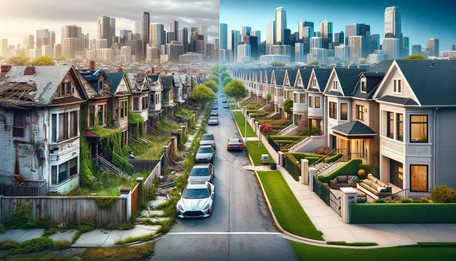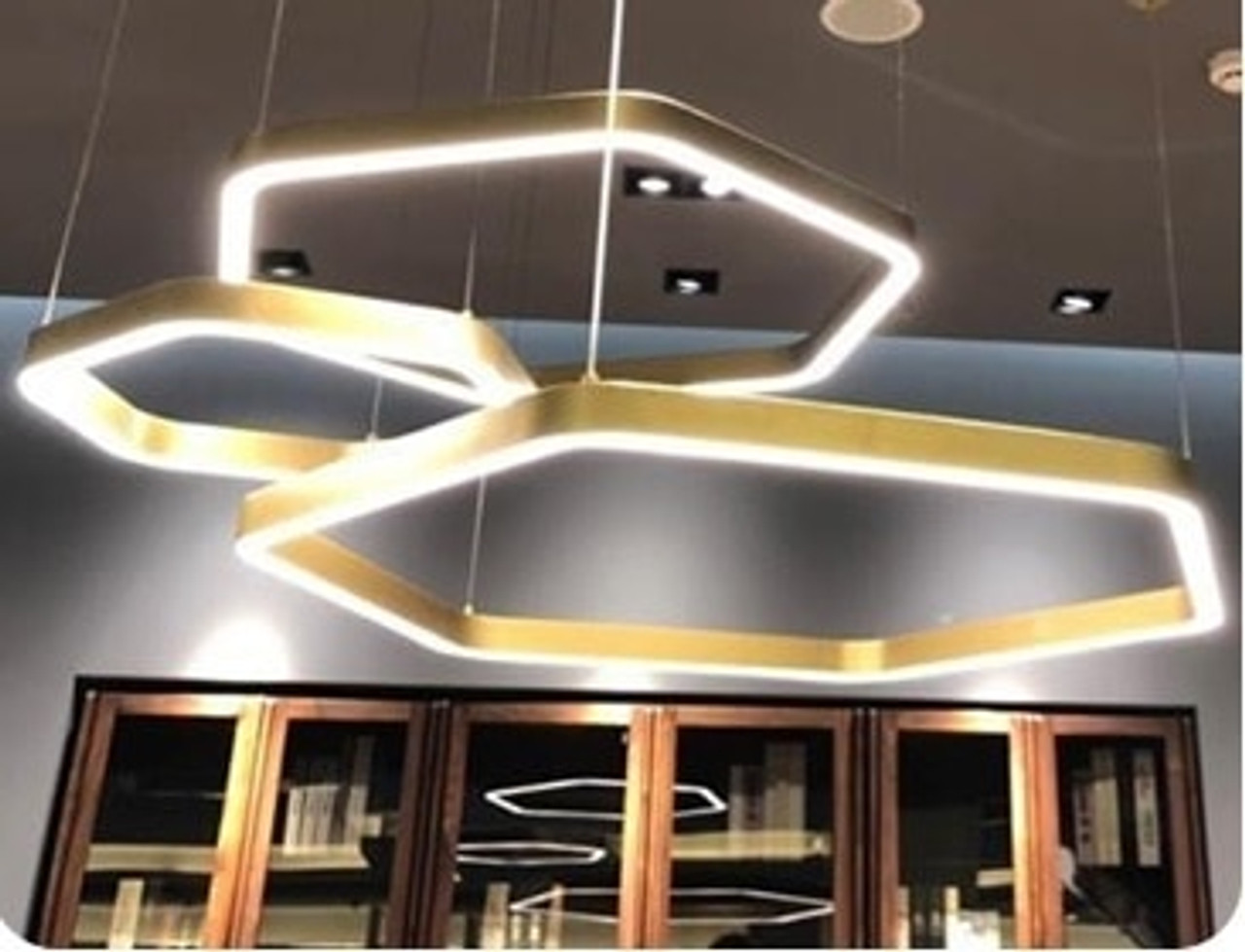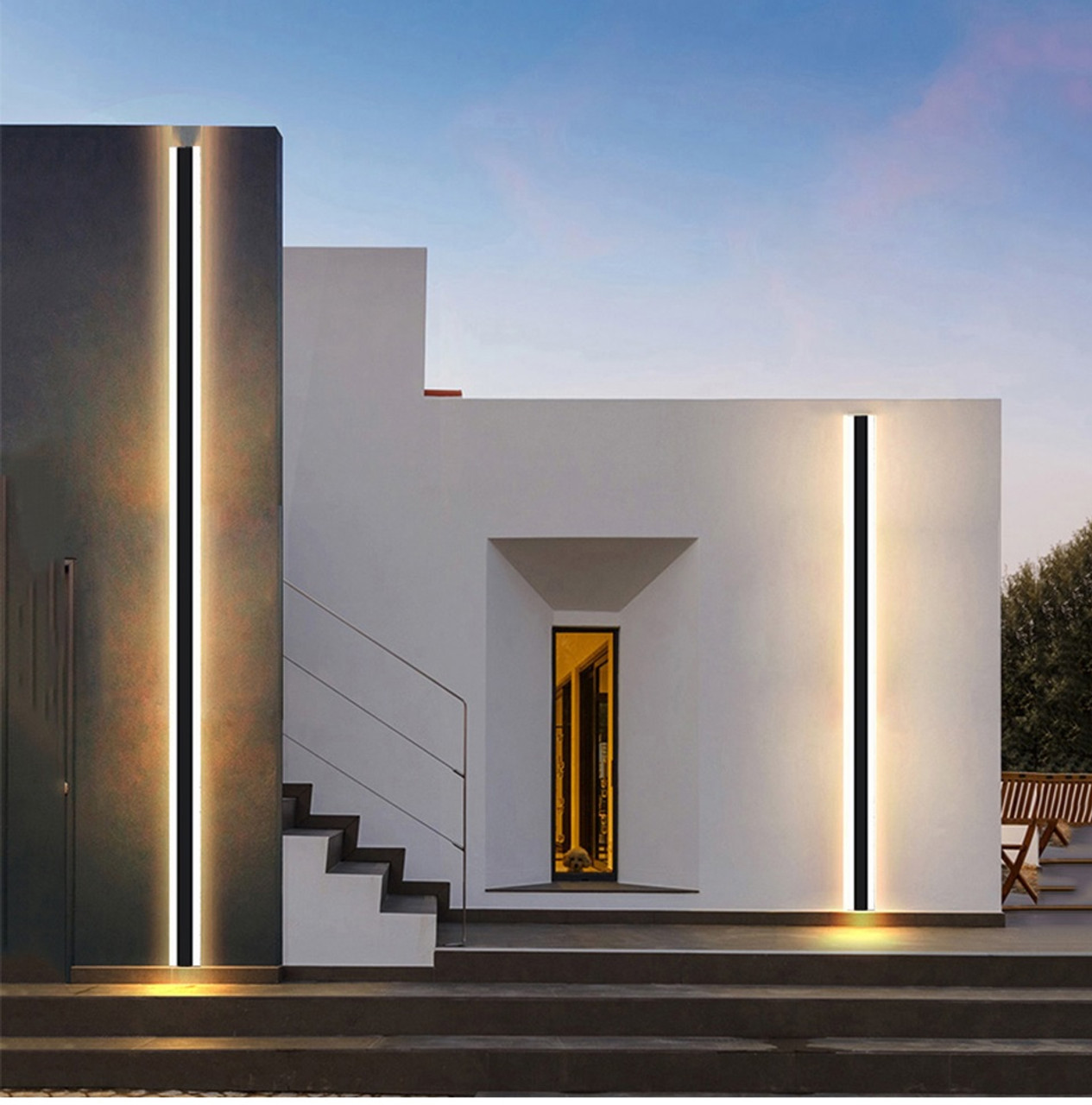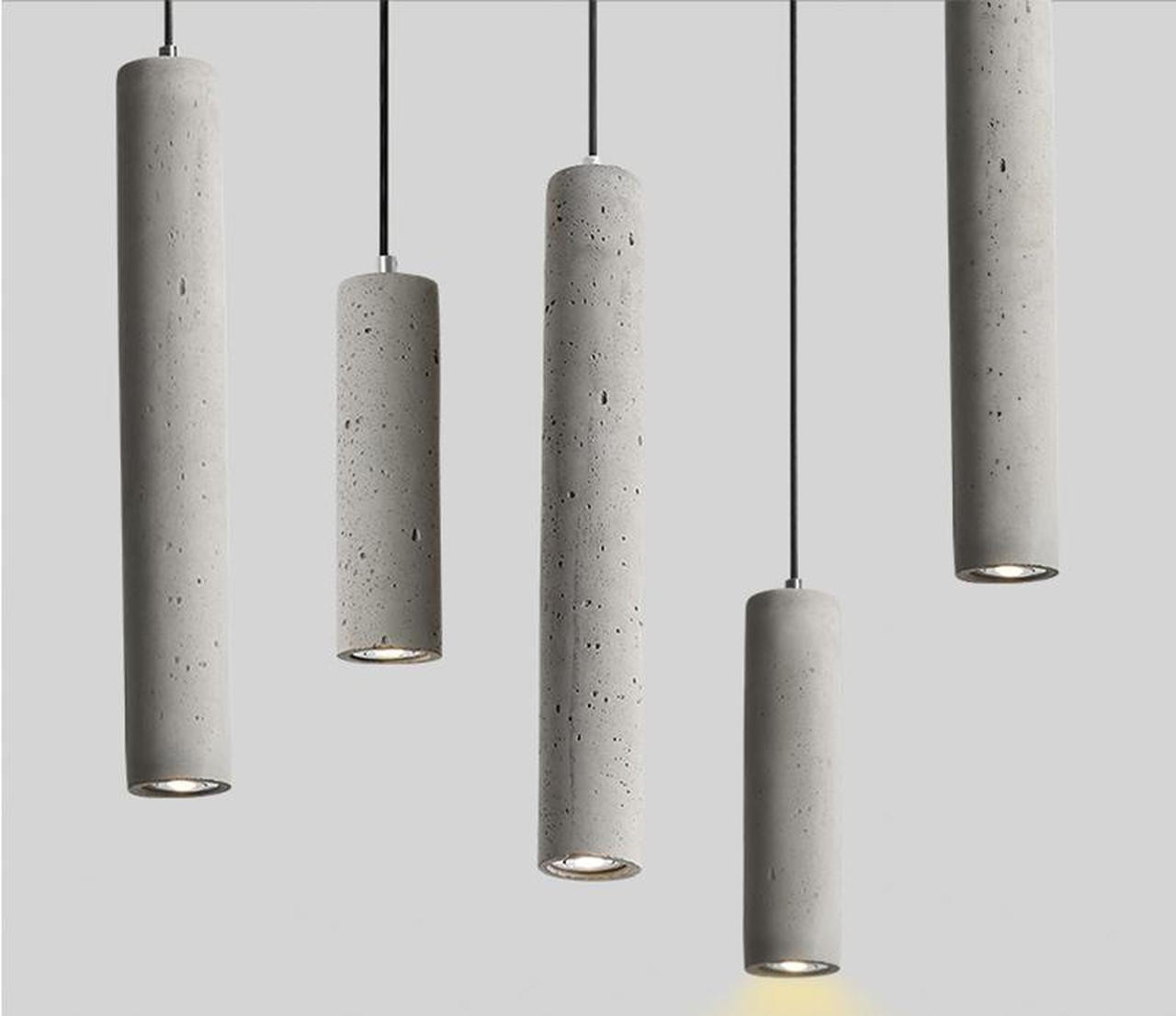Gentrify - Gentrification Meaning - Green Gentrification Neighborhoods
Jul 28, 2024
Gentrify - Gentrification Meaning - Green Gentrification Neighborhoods
Gentrification is a complex and multifaceted phenomenon affecting cities around the globe. It refers to the process by which lower-income neighborhoods undergo transformation through the influx of more affluent residents, leading to increased property values, displacement of long-term residents, and changes in the character and culture of the area. This process often involves the renovation of dilapidated buildings, the introduction of upscale businesses, and improvements in public infrastructure, which, while seemingly beneficial, carry significant socio-economic implications.
Understanding Gentrification
Gentrification typically begins when investors and more affluent individuals start moving into neglected or economically disadvantaged neighborhoods, attracted by lower housing costs and the potential for property value appreciation. As these new residents bring higher income into the area, demand for housing increases, leading to rising property values and rents. This economic shift can result in the displacement of existing residents, who may no longer afford to live in their neighborhoods, alongside the erosion of the area's cultural and social fabric.
Architects and Gentrification
Architects play a pivotal role in the gentrification process, as they are often at the forefront of designing and developing projects that can either contribute to or mitigate the impacts of gentrification. Their involvement in revitalizing buildings and public spaces can inadvertently attract wealthier clients and investors, accelerating the gentrification process. However, architects also possess the unique potential to design inclusively, with an emphasis on social equity and community engagement.
Ethical Considerations and Responsibility
Architects should approach projects with a comprehensive understanding of the socio-economic dynamics at play, striving to balance development goals with the needs and desires of existing residents. This includes adopting practices such as:
- Community-Centric Design: Engaging with the community to understand their needs, values, and aspirations can lead to more inclusive and equitable design outcomes. This engagement should be genuine and continuous, allowing for the co-creation of spaces that reflect and serve the entire community's interests.
- Affordable Housing Solutions: Incorporating affordable housing units in new developments can help mitigate displacement pressures and ensure that long-term residents can afford to stay in their neighborhoods.
- Preservation of Cultural Heritage: Recognizing and preserving the cultural and historical significance of neighborhoods can prevent the erasure of identity that often accompanies gentrification. Architects can incorporate elements that celebrate the area's heritage, contributing to a sense of continuity and belonging.
The Impact of Gentrification on Neighborhoods
The effects of gentrification on neighborhoods are deeply ambivalent and widely debated. On one hand, gentrification can lead to the beautification of areas, improved infrastructure, increased safety, and a broader tax base, which can enhance public services. On the other hand, it can result in cultural homogenization, loss of affordable housing, and the displacement of marginalized communities, exacerbating social inequality.
Economic Impacts
Economically, gentrification can lead to increased property values, which benefits property owners but can disadvantage renters and those on fixed incomes. The influx of wealthier residents and businesses can also alter the local economy, sometimes leading to the displacement of small, locally-owned businesses by chains and luxury stores, further eroding the neighborhood's unique character.
Social and Cultural Impacts
Socially and culturally, gentrification can lead to a sense of alienation among long-term residents as the familiar fabric of their community changes. The displacement of communities can fragment social networks and erode traditional cultural expressions, leading to a loss of community identity and cohesion.
Conclusion
Gentrification is a complex process with both positive and negative consequences for urban neighborhoods. While it can lead to the revitalization of areas and improvements in physical infrastructure, it also poses significant challenges in terms of displacement, social inequality, and cultural erasure. Architects, as key actors in the development of urban spaces, have a critical responsibility to consider the broader social impacts of their work. By prioritizing inclusive and equitable design practices, architects can help ensure that development benefits all residents, not just a privileged few. Ultimately, the goal should be to create resilient, vibrant, and inclusive communities that preserve their unique character while accommodating new growth and change.
Gentrification Pros and Cons
Gentrification is a contentious urban phenomenon with a range of positive and negative impacts on neighborhoods and their inhabitants. Understanding these effects is crucial for policymakers, urban planners, and community members alike. Here's a breakdown of the pros and cons of gentrification:
Pros of Gentrification
- Urban Revitalization: Gentrification often leads to the rehabilitation of dilapidated buildings and the construction of new housing and commercial spaces, contributing to urban renewal and beautification.
- Increased Property Values: Homeowners in gentrifying areas can benefit from rising property values, which can increase their wealth and investment in their homes.
- Improved Public Services: The influx of wealthier residents can lead to a broader tax base, enabling local governments to enhance public services such as parks, schools, and public transportation.
- Enhanced Safety: Gentrification is often associated with a decrease in crime rates as neighborhoods undergo economic and social transformations, leading to safer communities.
- Economic Development: New businesses, restaurants, and retail outlets that cater to the tastes and needs of new, wealthier residents can lead to job creation and economic diversification.
Cons of Gentrification
- Displacement of Residents: One of the most significant downsides of gentrification is the displacement of long-term, often low-income residents due to rising rents and property taxes, leading to the loss of housing affordability.
- Cultural Erosion: The character and culture of neighborhoods can change dramatically as new residents and businesses replace local institutions, leading to a loss of cultural identity and community cohesion.
- Social Segregation: Gentrification can exacerbate social inequality, segregating cities along economic lines as wealthier residents move into gentrified neighborhoods while lower-income populations are pushed to less desirable areas.
- Loss of Affordable Housing: The redevelopment of neighborhoods often focuses on higher-end housing and commercial spaces, leading to a decrease in affordable housing options for lower-income residents.
- Community Resentment: The influx of new residents and the perceived imposition of their values and lifestyles can create tension and resentment among existing community members, leading to social friction.
Balancing the Impacts
The challenge lies in finding a balance between revitalizing neighborhoods and preserving the rights and cultures of existing residents. Solutions such as inclusive zoning policies, affordable housing initiatives, and community engagement in development projects can help mitigate the negative impacts of gentrification while still reaping its benefits. By fostering dialogue and collaboration between new and existing residents, developers, and local governments, communities can work towards equitable urban development that benefits everyone.
Real World Examples of Gentrification
Gentrification has transformed numerous neighborhoods around the world, with notable examples in major cities across the United States, Europe, and beyond. These transformations often spark debates on urban development, social equity, and community preservation. Here are some real-world examples:
United States
- Williamsburg, Brooklyn, New York: Once a largely industrial area with a diverse population, Williamsburg has become synonymous with hipster culture and gentrification. Rapid development starting in the late 1990s and early 2000s, fueled by an influx of artists and young professionals seeking lower rents, led to soaring property values, the displacement of long-term residents, and a significant shift in the neighborhood's cultural and socio-economic landscape.
- The Mission District, San Francisco, California: Known for its vibrant Latino community and cultural richness, The Mission District has experienced intense gentrification pressures due to the tech boom. Rising housing costs have displaced many original residents, while upscale businesses and tech startups have moved in, altering the neighborhood's character.
- Shaw and Columbia Heights, Washington, D.C.: These neighborhoods have undergone significant changes over the past few decades. Once predominantly African-American communities with high crime rates, extensive investment and development have transformed them into sought-after areas with a mix of upscale apartments, restaurants, and retail outlets, leading to concerns about displacement and cultural dilution.
United Kingdom
- Shoreditch, London: Shoreditch has transitioned from a working-class area to a hub of creativity and gentrification. The influx of tech companies, alongside a thriving arts scene, has increased property prices and rent, pushing out older businesses and residents and changing the area's demographic makeup.
Canada
- Downtown Eastside, Vancouver: Known as one of Canada's poorest neighborhoods, the Downtown Eastside has seen increasing gentrification. Efforts to revitalize the area have led to tensions between developers, new residents, and the existing community, who are concerned about rising homelessness and the loss of affordable housing.
Brazil
- Vila Madalena, São Paulo: Originally a bohemian neighborhood with a strong artistic presence, Vila Madalena has experienced rapid gentrification. The influx of wealthier residents and tourists attracted to its cultural scene has led to increased property values, making it difficult for long-term residents and local artists to afford living and working in the area.
Observations and Outcomes
These examples highlight common patterns of gentrification: initial attraction due to cultural or economic opportunities, followed by increased investment and development. This often leads to displacement of original residents and a transformation of the area's identity. While gentrification can bring about positive changes such as economic development and improved infrastructure, it also raises critical concerns about social equity, community displacement, and the loss of cultural diversity. Balancing development with the needs and desires of existing communities remains a key challenge in urban planning and policy.
What is Green Gentrification?
Green gentrification, also known as "environmental gentrification," refers to a process where the introduction or enhancement of green infrastructure (such as parks, greenways, and clean transportation options) in urban neighborhoods leads to increased property values and living costs, attracting more affluent residents and potentially displacing the existing, often lower-income, populations. This phenomenon highlights a paradox where efforts to make cities more sustainable and environmentally friendly can inadvertently contribute to social inequality and displacement.
Characteristics of Green Gentrification
- Investment in Green Spaces: The creation or revitalization of parks, community gardens, riverfronts, and other green spaces can make neighborhoods more attractive to higher-income individuals seeking quality-of-life improvements. While these investments are generally positive, they can also make the area less affordable for existing residents.
- Sustainable Urban Development: Efforts to develop or retrofit urban areas with sustainable features, such as energy-efficient buildings and improved public transportation, can lead to a perception of the neighborhood as more desirable, again potentially pricing out current residents.
- Climate Gentrification: In some cases, areas that are perceived as more resilient to climate change impacts (such as higher ground in flood-prone cities) become more desirable, leading to increased property values and the displacement of vulnerable communities.
Examples of Green Gentrification
- The High Line, New York City: The transformation of an abandoned elevated railway into a popular linear park sparked significant real estate investment in the surrounding neighborhoods of Chelsea and the Meatpacking District, leading to rising property values and concerns about the displacement of existing residents and businesses.
- Cheonggyecheon Restoration, Seoul, South Korea: The restoration of the Cheonggyecheon stream in Seoul revitalized a neglected area of the city, improving environmental conditions and creating a popular recreational space. However, it also led to increased property values and rent, affecting small businesses and residents in the area.
Addressing Green Gentrification
To mitigate the effects of green gentrification, urban planners and policymakers are exploring strategies that include:
- Inclusive Planning Processes: Engaging community members in the planning and development of green projects to ensure that improvements meet the needs of all residents.
- Affordable Housing Policies: Implementing policies that protect or expand affordable housing options in neighborhoods undergoing greening to prevent displacement.
- Equitable Investment: Distributing green infrastructure investments more evenly across the city to avoid concentrating benefits and associated gentrification pressures in specific neighborhoods.
Green gentrification underscores the need for a balanced approach to urban development that prioritizes both environmental sustainability and social equity, ensuring that the benefits of greener cities are accessible to all residents.
Gentrify effects on the environment
The effects of gentrification on the environment can be both direct and indirect, reflecting a complex interplay between urban development, social dynamics, and environmental sustainability. Here are some key points to consider:
Positive Effects
- Green Infrastructure Development: Gentrification often leads to investments in green infrastructure, such as parks, green roofs, and community gardens. These developments can improve air quality, reduce urban heat islands, and increase biodiversity in previously neglected urban areas.
- Improved Public Transit and Walkability: To appeal to new residents, gentrifying areas may see improvements in public transportation and the development of pedestrian-friendly spaces. This can reduce reliance on cars, thereby decreasing carbon emissions and contributing to cleaner air.
- Energy-Efficient Buildings: Gentrification can spur the renovation of old buildings with energy-efficient materials and technologies, reducing energy consumption and promoting a more sustainable urban environment.
Negative Effects
- Displacement and Sprawl: One of the most significant environmental downsides of gentrification is the displacement of existing communities. As people are pushed out of gentrifying neighborhoods due to rising costs, they may move to more affordable areas on the urban periphery, contributing to urban sprawl. This sprawl can lead to increased vehicle emissions, loss of green spaces, and greater energy consumption.
- Increased Waste and Consumption: New, wealthier residents may lead to higher levels of consumption and waste production, straining local resources and waste management systems. The construction associated with gentrification can also generate significant amounts of waste and pollution.
- Climate Gentrification: In some cases, gentrification can occur in areas deemed safer from climate change impacts, such as higher ground away from flood zones. This can lead to environmental injustices where more vulnerable populations are pushed into areas with greater environmental risks.
- Loss of Green Spaces: While gentrification can lead to the creation of new green spaces, it can also result in the loss of existing community gardens or informal green spaces that have been managed by local communities, particularly if these areas are redeveloped for high-end residential or commercial uses.
Balancing Environmental and Social Outcomes
Addressing the environmental impacts of gentrification requires a balanced approach that considers both the ecological benefits and the social consequences. Policies and practices that promote affordable housing, equitable access to green spaces, sustainable transportation options, and community-led urban planning can help mitigate the negative environmental impacts of gentrification. Ensuring that environmental improvements benefit all residents, rather than displacing them, is crucial for achieving sustainable and equitable urban development.
Real World Green Gentrification Examples
Green gentrification occurs when efforts to add or improve green amenities in urban neighborhoods lead to increased property values and the displacement of lower-income residents. Here are some real-world examples of green gentrification:
The High Line, New York City, USA
Perhaps one of the most cited examples of green gentrification, the High Line is a linear park built on a historic freight rail line elevated above the streets on Manhattan’s West Side. Since its opening in 2009, the High Line has become a major tourist attraction and spurred significant real estate development in the surrounding neighborhoods. Property values in the vicinity have skyrocketed, leading to concerns about the displacement of long-time residents and businesses.
Parque Madrid Río, Madrid, Spain
Madrid Río is an extensive urban park along the banks of the Manzanares River in Madrid, created as part of a major urban redevelopment project that buried a section of the M-30 ring road. The park has revitalized previously neglected areas, offering green spaces, recreational facilities, and cultural venues. While it has enhanced the quality of life in surrounding neighborhoods, it has also attracted new development and higher-income residents, impacting housing affordability.
Cheonggyecheon Restoration, Seoul, South Korea
The Cheonggyecheon restoration project transformed an overground highway into a nearly 6-kilometer-long urban park in downtown Seoul. Completed in 2005, the project aimed to improve environmental conditions and provide public space. It succeeded in attracting tourists and boosting local businesses but also led to increased property values and concerns about the displacement of small businesses and lower-income residents in the area.
The 606 (Bloomingdale Trail), Chicago, USA
The 606 is an elevated linear park, trail, and greenway on the northwest side of Chicago, built on a former rail line. Since its opening in 2015, the trail has provided valuable recreational space and connected several neighborhoods. However, its construction has been associated with rising property values and taxes in adjacent areas, leading to displacement pressures on long-standing, lower-income communities.
Eastside Greenway, London, UK
The Eastside Greenway project in London, part of the larger redevelopment associated with the London 2012 Olympic Games, aimed to create a network of green spaces and pedestrian paths in East London. While the project sought to improve environmental quality and accessibility, it has also been linked to rising housing costs and the gentrification of nearby neighborhoods, affecting the affordability for existing residents.
These examples highlight the challenges of implementing urban green spaces without triggering unintended socio-economic consequences. Balancing environmental improvements with equitable development strategies is crucial to ensure that green amenities benefit all residents without leading to displacement.
Final Thoughts on Historic Preservation and Gentrification
Historic preservation and gentrification are deeply intertwined phenomena that can significantly impact urban neighborhoods. While both processes aim to improve urban environments, they do so in ways that can either conflict with or complement each other. Here are some thoughts on how historic preservation intersects with gentrification:
Potential Benefits of Historic Preservation in the Context of Gentrification
- Cultural and Historical Continuity: Historic preservation can safeguard the cultural and historical character of neighborhoods, maintaining their unique identity amidst change. This can be particularly important in gentrifying areas, where rapid development risks erasing local heritage.
- Economic Stimulation Without Displacement: Ideally, historic preservation can stimulate local economies by attracting tourism and fostering a sense of community pride, potentially leading to increased property values. However, unlike typical gentrification, which often results in new constructions, preservation can limit the scale of development and maintain the existing urban fabric, possibly mitigating some displacement pressures.
- Sustainable Development: Preserving and repurposing existing buildings is inherently sustainable, reducing the need for new materials and construction. This approach can contribute to a gentrification process that values environmental conservation alongside economic development.
Challenges and Concerns
- Exacerbation of Gentrification Pressures: Historic designation can also increase property values and taxes, making it more difficult for existing residents and businesses to afford to stay in their neighborhoods. This can particularly impact lower-income residents and contribute to displacement, a key concern of gentrification.
- Selective Preservation and Inequality: Historic preservation can sometimes reflect and reinforce existing social inequalities. Which buildings and neighborhoods are deemed "historic" often depend on who has the power to make those decisions, potentially leading to a selective preservation that favors wealthier, more influential communities.
- Regulatory Challenges: The regulations associated with historic preservation can be both a blessing and a curse. They can protect the architectural integrity of neighborhoods but also impose limitations on property owners, potentially discouraging affordable housing developments or necessary modernizations that could benefit the community.
Striking a Balance
Finding a balance between historic preservation and the dynamics of gentrification requires thoughtful policy-making and community engagement. Strategies might include:
- Inclusive Decision-Making: Ensuring that the process of designating historic landmarks and districts involves a wide range of community stakeholders, including those who might be most affected by gentrification pressures.
- Affordable Housing Protections: Implementing policies that protect and expand affordable housing within historic districts to ensure that preservation efforts do not lead to displacement.
- Economic Incentives: Offering tax incentives, grants, or other financial assistance to property owners for maintaining and rehabilitating historic properties, especially for affordable housing projects.
In conclusion, while historic preservation can contribute to the aesthetic and cultural enrichment of urban neighborhoods, it must be carefully managed to avoid exacerbating gentrification and displacement. By prioritizing inclusivity, sustainability, and social equity, communities can leverage the benefits of preservation while mitigating its potential downsides.








